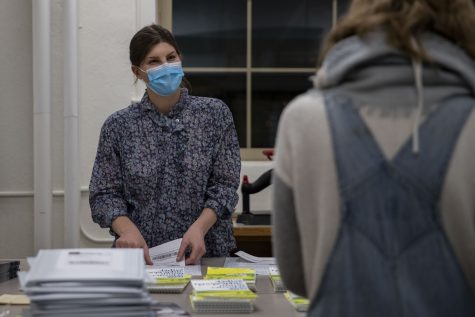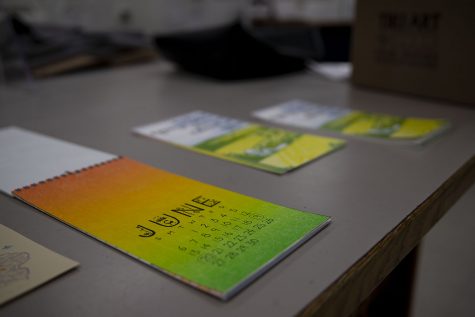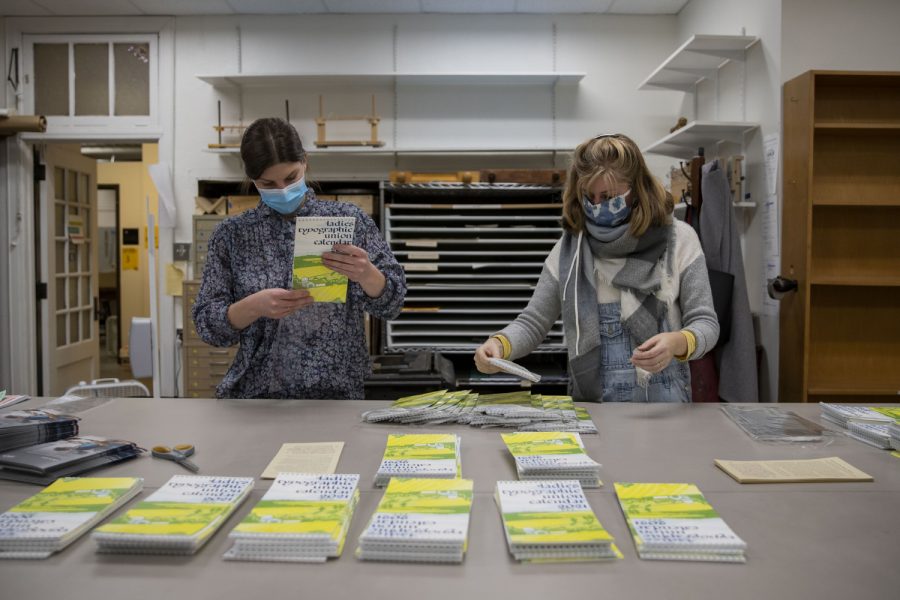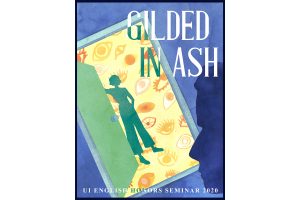Ladies Typographic Union create 2021 hand pressed calendar
Each month of the calendar is decorated in the unique style of individual artists, and has already sold out of physical copies for 2021.
Second-year MFA candidates for the University of Iowa Center for the Book Madison Bennett (left) and Kimberly Obee (right) organize calendar orders for the Ladies Typographic Union on Tuesday, Dec. 15, 2020 in North Hall. After selling calendars for over a decade, this year is first time that the calendars have been available online.
December 15, 2020
Every year for more than a decade, graduate students at the University of Iowa’s Center for the Book’s Ladies Typographic Union have made a hand-pressed calendar. This year — the center’s first time selling the student-designed calendars online — 200 physical copies sold out in nine hours.
Buyers of the calendars who snatched up copies before they sold out will hold the print version in their hands for the first time on Dec.16.
Each month of the calendar is an individual art piece, the entire page decorated with intricate and meaningful details specific to the artists who crafted them.

One graduate student in charge of constructing the calendar this year, Madison Bennett, said it’s easy to take the hard work that goes into hand crafting the calendar for granted, but each calendar represents something bigger than anything that can be bought online.
“The calendar represents hundreds of hours of work and labor, and was touched by the people that designed it,” she said. “There’s an energy to this calendar where there’s so much love and work that has been put into it.”
To the artists designing the pages for each month, there’s comfort in the artistic freedom that many of them enjoy exploring.
Bennett describes this personalization from the artists as “little Easter eggs.” One artist included a dot next to her birthday, another put a mark next to his wife’s. Juneteenth is circled in the month of June.
Bennett said the best part about owning the print copies is that consumers are also able to receive some of this love and hard work in a physical object.
RELATED:UI students rewrite The Great Gatsby through 21st century genre: fanfiction
A graduate student through the book-arts program at the UICB who led the project last year, Amy Childress, explained that there’s something comforting about the press and printing to the students involved in the craft of letter pressing the calendars, despite how labor intensive the machines are at the Center for the Book.
“You’ve produced this object or print that you’ve made all by yourself, and it’s just so satisfying,” she said.
Letterpress printing by hand is time-consuming, Bennett said. The pages run through the machine, pressing only one color onto the page at a time to create the images. This year’s cover required six runs through the press, taking 40 hours to complete.
Because of this time-consuming process, the students must limit the number of copies they were able to sell. Barrett explained that the range of copies is usually about 150-200. This year, the organization sold 200 copies.
Another contributor for the project, Rachel Schend, used knowledge from her Art History while designing her layout and looked at older artwork for inspiration. This year, she decided to base her month, September, off of turn of the century Dutch calendars that include the days of the week on the side.

“I was intrigued by the Art Deco geometric style, but also the layout,” Schend said. “I thought it was more unique than what you see nowadays.”
Because of the limited number of copies and extended labor that hand pressing means for students, all the print copies are sold out. Digital copies are, however, available on the Ladies Typographic Union website.
Bennett added that this opportunity to sell digital copies allows the calendars to be seen as the art objects they are and is optimistic that more people will see the calendars as art in the future, too.
“As book artists, I think we’ve struggled for the last 50 years or so as people have created art within their books,” Bennett said. “But as we move more digital, I think people will have an understanding of a physical book as a valuable piece of art and an art object.”




